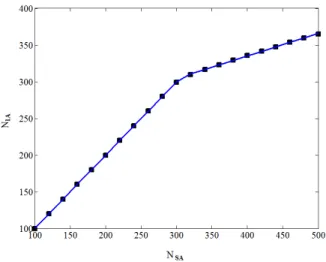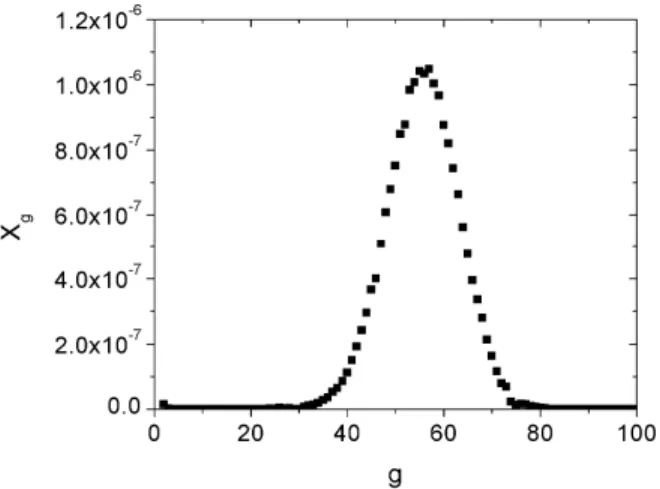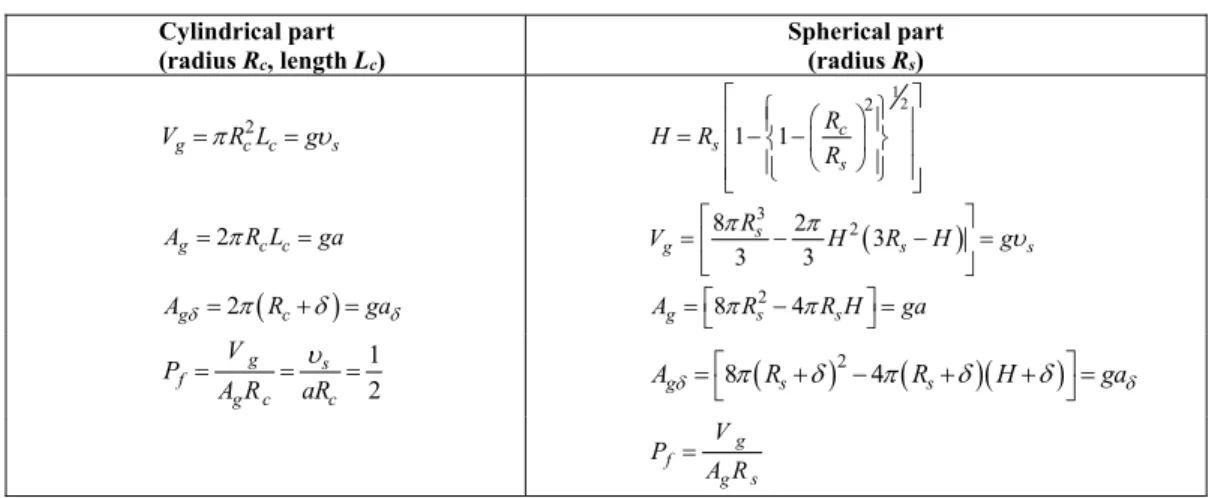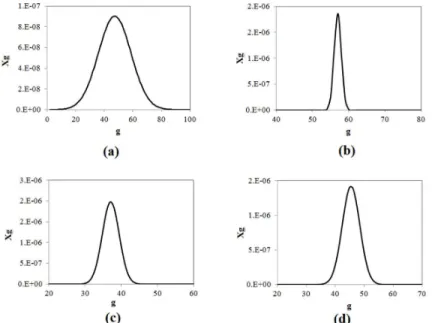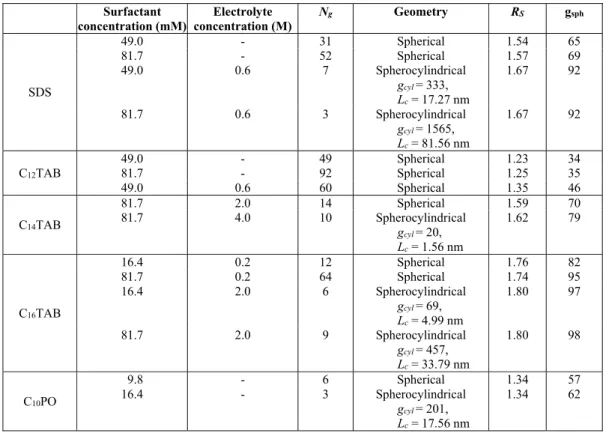ISSN 0104-6632 Printed in Brazil
www.abeq.org.br/bjche
Vol. 33, No. 03, pp. 515 - 523, July - September, 2016
dx.doi.org/10.1590/0104-6632.20160333s20150129
Brazilian Journal
of Chemical
Engineering
MOLECULAR THERMODYNAMICS OF
MICELLIZATION: MICELLE SIZE DISTRIBUTIONS
AND GEOMETRY TRANSITIONS
M. S. Santos
1, F. W. Tavares
1,2*and E. C. Biscaia Jr
11Programa de Engenharia Química/COPPE, Universidade Federal do Rio de Janeiro,
C.P. 68502, CEP: 21941-972, Rio de Janeiro, RJ - Brazil. E-mail: tavares@eq.ufrj.br
2Escola de Química, Universidade Federal do Rio de Janeiro, CEP: 21941-909,
Rio de Janeiro - RJ, Brazil.
(Submitted: February 26, 2015 ; Revised: June 10, 2015 ; Accepted: June 18, 2015)
Abstract - Surfactants are amphiphilic molecules that can spontaneously self-assemble in solution, forming structures known as micelles. Variations in temperature, pH, and electrolyte concentration imply changes in the interactions between surfactants and micelle stability conditions, including micelle size distribution and micelle shape. Here, molecular thermodynamics is used to describe and predict conditions of micelle formation in surfactant solutions by directly calculating the minimum Gibbs free energy of the system, corresponding to the most stable condition of the surfactant solution. In order to find it, the proposed methodology takes into account the micelle size distribution and two possible geometries (spherical and spherocylindrical). We propose a numerical optimization methodology where the minimum free energy can be reached faster and in a more reliable way. The proposed models predict the critical micelle concentration well when compared to experimental data, and also predict the effect of salt on micelle geometry transitions.
Keywords: Micellization; Molecular thermodynamics.
INTRODUCTION
Self-assembly is a broad term applied to spontane-ous organization of substances under appropriate con-ditions and proportions. It is a reversible process and represents a condition of thermodynamic equilibrium, which is relevant to a large variety of phenomena and systems, such as crystal formation, colloidal systems, lipid bilayers, among others (Whitesides and Boncheva, 2002). When surfactants self-assemble, the structures formed are called micelles. Micellization phenomena have been of great interest to both the academic com-munity and industry. It is involved in several applica-tions and processes. We can mention its application in personal care products, paints, processed food, and
The molecular thermodynamics approach to de-scribe the micellization phenomena was first pro-posed by Tanford (Tanford, 1974). Tanford analyzed the adequacy of the Gibbs thermodynamic equilib-rium to describe the self-assembly of amphiphilic molecules. In Tanford’s work, the equilibrium state is calculated by imposing the necessary condition of a stoichiometric linear relation of chemical potential of all species. That implies that the sum of the Gibbs free energies of reactants (amphiphilic molecules) must be the equal to the sum of the Gibbs free energies of products (micelles).
Molecular thermodynamic models aim to be com-pletely predictive. They describe the micellization phenomena only based on information about the molecular characteristics of substances and conditions of the medium, such as, for example, temperature, sur-factant concentration, and ionic strength (Goldsipe and Blankschtein, 2007). Nagarajan and collaborators made important contributions to the development of molecular thermodynamic models used to describe the self-assembly of surfactant solutions. In their models (Nagarajan and Ruckenstein, 1991; Naga-rajan, 1993; NagaNaga-rajan, 2002) they analyzed small and monodisperse micelles and also the transition between two micelle geometries. However, in those works, only the necessary condition for equilibrium is considered. The Nagarajan model was improved by Moreira and Firoozabadi (2009) when they started considering the minimum of Gibbs free energy as a condition for the thermodynamic equilibrium of the solution. However, Moreira and Firoozabadi (2009) used the maximum term approach, which assumes that the micelle size distribution can be represented by one characteristic micelle size and a single number of micelles formed. Therefore, Moreira and Firoozabadi (2009) did not take into account the fact that micelles can be formed with a large distribution of sizes. They also assumed that only small micelles could be formed, with either a spherical or globular shape. In their subsequent works (Moreira and Firoozabadi, 2010; Moreira and Firoozabadi, 2012; Lukanov and Firoozabadi, 2014) those aspects were kept the same. Therefore, to the best of our knowledge, the present work is the only one that considers the minimum Gibbs free energy as the most stable state together with the micelles’ size distributions and also analyzes the transition between small (spherical) and rod-like (spherocylindrical) micelles as a function of tempera-ture and salt concentration.
In this work we present an approach where the mini-mum of total Gibbs free energy is obtained for aque-ous surfactant solutions (with and without electro-lytes) considering the micelle size distributions and
the more stable geometry (spherical and spherocylin-drical) of micelles. Here, the stable state for a given set of temperature (T), pressure (P) and composition (N), obtained by the minimization of total Gibbs free energy of the system, gives us information about the most stable micelle geometry, micelles sizes and the critical micelle concentration (CMC) of the solution.
MODEL
The model used to calculate the total Gibbs free energy of the system is similar to the one proposed by Nagarajan and Ruckenstein (1991) and Moreira and Firoozabadi (2009). Given a global specification of T
(temperature), P (pressure),NSA (total number of sur-factant molecules in the solution) and Nw (number of water molecules), the Gibbs free energy is calculated as a sum of two contributions: free energy of for-mation and free energy of mixture.
1 2
1 4
2
ln ln ln
o o o
w w sA A g g
g
w w A g g
g
G N N N g
kT N X N X N X
(1)
where wo, 1oA and go are the standard chemical
potentials of water, free surfactant and micelle with aggregation number g, Ng is the number of micelles, k
is the Boltzmann constant, and Xw, X1Aand Xg are the
mole fractions of water, free surfactant and micelles. It is possible to reorganize the previous expression by separating the terms that depend only on fixed variables: T, P, NSA,and Nw,and dividing the
expres-sion by kT:
2 1 1 2 ln ln ln
o gg w w
g
A A g g
g
G
N g N X
kT kT
N X N X
(2)
Equation (2) represents the expression to be mini-mized to predict the most stable state of the system.
The free energy of micellization o g kT
is defined as
(1991) and Moreira and Firoozabadi (2009).
When the micelles size distribution is narrow enough, it is common to use the Maximum Term ap-proximation. when the Maximum Term approxi-mation is used, Equation (2) becomes:
1 1
ln
ln ln
o g
g w w
A A g g
G
N g N X
kT kT
N X N X
(3)
METHODOLOGY
Critical Micelle Concentration (CMC)
Experimentally, the critical micelle concentration (CMC) is defined as the concentration of surfactant where a sharp change in any property of the solution is observed. This information is available in the literature for a wide variety of surfactants. Therefore we decided to validate our model by comparing our predictive calculations with experimental CMC data. To obtain the CMC, we perform different simulations of a solution containing an increasing amount of sur-factant. Then, for each solution with a different amount of surfactant added we performed the minimization of the Gibbs free energy. This procedure permits one to relate the total number of surfactant molecules added (NSA) with the number of free surfactant molecules in
the solution (N1A), as is graphically presented in
Figure 1. The CMC is then defined as the concentra-tion of surfactant added (NSA) where an inflexion of
the curve is observed. To obtain this point automati-cally, a regularization function is used which relates
N1A as a function of NSA, according to Equation (4).
1
2 2
1
a SA SA SA SA
SA SA
SA SA
N N a N b c N N
N N
N N
(4)
where NSA*, determined by non-linear regression,
corresponds to the critical number of surfactant molecules added to the solution under the conditions
T and P, and ξ is the regularization parameter, where 1 0. The parameters a, b, and c are obtained from the fitting of the data to the regularization function.
To perform the parameter fitting we used the
deterministic method Sequential Quadratic Program-ming (SQP). After obtaining the concentration of surfactant added (NSA), we can calculate the critical
micelle concentration using the number of water molecules assumed in the simulation (NW).
Figure 1: Determination of the CMC. Each point repre-sents one minimization process of the Gibbs free en-ergy and the continuous line is the adjusted regulation function. CMC is obtained by parameter fitting of the regularization function represented by Equation (4).
Micelle Size Distribution
To develop the methodology for the micelle size distributions, first we verify what kind of behavior this distribution can have. For that, we consider a set of optimization variables, where it is assumed that we could obtain micelles with an aggregation number from 2 to 100. To construct the next figure, we define as optimization variables the vector of the number of micelles formed for each aggregation number g. Thus, for this specific case we did not pre-set any shape for the micelle size distribution. Figure 2 shows the tendency obtained for the micelle size distribution for an aqueous solution of sodium dodecyl sulfate (SDS) at a concentration ten times higher than its critical micelle concentration. It is interesting to observe that the problem converges to a micelle size distribution with a behavior similar to a Gaussian distribution.
From now on in this work, a Gaussian shape is as-sumed for all the micelle size distributions. Therefore, it is possible to define the total number of micelles formed, the mean (or expectation) aggregation num-ber of the distribution and its standard deviation as important variables for calculating the minimum free energy of the system.
distribution, first we compared it with the maximum term approach, both considering the minimum Gibbs free energy to define the most stable state. Because we calculate the critical micelle concentration, only small micelles are considered (spherical and globular shapes only). The geometrical relations used for this section are similar to those presented by Nagarajan and Ruck-enstein (1991). Using our methodology, three optimi-zation variables, as mentioned before, are used to cal-culate each minimum of Gibbs energy. Using the Maxi-mum Term Approximation, we have two optimization variables: the number of micelles formed, Ng, and the
specific aggregation number, g.
Figure 2: Micelle size distribution for a solution of sodium dodecyl sulfate (SDS) at a concentration ten times its critical micelle concentration. Xg is the mole
fraction of micelles with the aggregation number g. T
= 25 ºC, P = 1 atm, and Nw = 3400000. The micelle size distribution converges to a Gaussian-like distribu-tion after the optimizadistribu-tion procedure.
Geometry Optimization
As in all optimization problems, we must pay at-tention to the correct definition of the optimization variables to be used in the numerical algorithm. The incorrect selection of variables, if they do not satisfy some constraints or correspond to an over specifica-tion, may lead to erroneous results and misinterpreta-tions. It is even more important when using nondeter-ministic algorithms because the analyticity of the functions and equality constraints are not taken into account. This can result in objective functions with several local minima.
Analyzing the geometric relations presented in Table 1, we can observe that, if the length of the cylin-drical part of the micelle (Lc) is zero, the geometry
reduces to a spherical micelle. For cases where the
geometric transition is considered, we define as opti-mization variables the number of micelles formed (Ng), the number of surfactant molecules in the
cy-lindrical part of the micelle (gcyl), the radius of the
spherical ends of the micelles (Rs), and the length of
the cylindrical part (Lc). The number of surfactant
molecules in the spherical ends of the micelle is then obtained from the geometric relations presented in Table 1, which assumes the form of:
3 2
1 8 2
3
3 3
sph s s
s
g R H R H
(5)
To reduce the optimization search region, we defined limits for the optimization variables. The maximum value of the radius, Rs, is assumed to be
equal to the extended length of the surfactant tail, en-suring that there is no empty space inside the micelle. Besides that, Rs must be equal to or greater than the
radius of the cylindrical part of the micelle to ensure that the amount of surfactant molecules in the spheri-cal ends is positive. Figure 3 presents a surface of the Gibbs energy, to be minimized, fixing values for Lc
and Rs. We can observe that the function has a smooth
behavior and a well-defined global minimum.
Numerical Method
Table 1: Geometric relations for a spherocylindrical micelle.
Cylindrical part (radius Rc, length Lc)
Spherical part (radius Rs)
2
g c c s
V R L g
1 2
2
1 1 c
s
s
R H R
R
2
g c c
A R L ga
3 2
8 2
3
3 3
s
g s s
R
V H R H g
2
g c
A R ga Ag8Rs24R Hs ga
1 2
g s
f
g c c
V P
A R aR
2
8 4
g s s
A R R H ga
g f
g s
V P
A R
Vgis the volume of the micelle, Ag is its surface area, Agδ is its area at a distance δ from the surface, Pf is the packing factor,
and R is the radius of the micelle (s for the spherical part and c for the cylindrical part). Variable H is a geometrical parameter. The expression of the volume of the surfactant tail (υs), as well as molecular parameters for different surfactants are presented
elsewhere (Nagarajan and Ruckstein, 1991).
Figure 3: Typical example of the Gibbs energy, /
G kT, as a function of the number of micelles with aggregation number g, Ng, and the number of
surfac-tant molecules in the cylindrical part of the micelle,
gcyl. We fixed the values of the length of the cylindrical
part of the micelle, Lc, and the radius of the spherical
ends of the micelles, Rs, to be equal to 2.89 nm and
1.23 nm, respectively.
RESULTS AND DISCUSSION
Figure 4 presents the critical micelle concentration (CMC) for different surfactants as a function of their tail length. To perform these calculations we assumed that micelles are globular or spherically shaped. The performance of the maximum term method and the
micelle size distribution method were compared. We observe that both methodologies are in very good agreement and predict the critical micelle tions well. We expect that at low surfactant concentra-tion (close to the CMC) the micelle-size distribuconcentra-tion tends to be narrower, compared with high surfactant concentration. For example, in Figure 5 we present the micelle size distribution for different surfactants at different concentrations. We observe relatively wide size distributions for all the cases presented in Figure 5, meaning that, for those cases, the Maximum Term method certainly is not the best approach. We expect wider distributions for high surfactant concentration or for microemulsion systems, in which case the methodology proposed here becomes more adequate to describe those systems. Another aspect that moti-vates the use of the size distribution approach pro-posed here is because sizes (mean, variance and other moments of the distribution) are important infor-mation for the stability of emulsions. For example, when an electric field is applied to an emulsion, its stability is a function of the diameter of the micelles to the fourth power.
We also proposed a methodology to describe the micelle geometry transitions. The results obtained are presented in Table 2. The surfactant dodecyl
trime-thylammonium bromide (C12TAB) forms spherical
to the surfactant solution causes the formation of sphe-rocylindrical micelles for tetradecyl
trimethylammo-nium bromide (C14TAB), and hexadecyl
trime-thylammonium bromide (C16TAB). For the nonionic
surfactant, decyl(dimethyl)phosphine oxide (C10PO),
the model predicts the formation of spherocylindrical micelles even without electrolytes added to the solu-tion, but at higher surfactant concentrations. In general, we are in good qualitative agreement with the trends observed by experiments.
Figure 4: Critical micelle concentration (CMC) for different surfactants in aqueous solutions obtained by the maximum term method (continuous lines), and the size distribution methodology (dashed lines). The squares are experimental data (Khan and Shah, 2008; Neves et al., 2007; Evans, 1956; Zhao et al., 2012, Velázquez and Lopez-Días, 2007). (a) Sodium nc-alkyl sulfate, (b) nc-alkyl pyridinium bromide, (c) nc-alkyl trimethylammonium
bromide, (d) nc-alkyl(dimethyl)phosphine.
Figure 5: Micelle size distributions for different surfactants obtained by the proposed methodology. is the molar
fraction of micelles with aggregation number : (a) 16.34 mM SDS solution; (b) 81.7 mM C12TAB solution; (c)
32.68 mM C14TAB solution; (d) 32.68 mM C16TAB solution. We defined = 25 ºC, P = 1 atm, and Nw = 3400000.
g
X
g
Table 2: Geometry transition between spherical and spherocylindrical micelles.
Surfactant concentration (mM)
Electrolyte concentration (M)
Ng Geometry RS gsph
SDS
49.0 - 31 Spherical 1.54 65
81.7 - 52 Spherical 1.57 69
49.0 0.6 7 Spherocylindrical
gcyl = 333,
Lc = 17.27 nm
1.67 92
81.7 0.6 3 Spherocylindrical
gcyl = 1565,
Lc = 81.56 nm
1.67 92
C12TAB
49.0 - 49 Spherical 1.23 34
81.7 - 92 Spherical 1.25 35
49.0 0.6 60 Spherical 1.35 46
C14TAB
81.7 2.0 14 Spherical 1.59 70
81.7 4.0 10 Spherocylindrical
gcyl = 20,
Lc = 1.56 nm
1.62 79
C16TAB
16.4 0.2 12 Spherical 1.76 82
81.7 0.2 64 Spherical 1.74 95
16.4 2.0 6 Spherocylindrical
gcyl = 69,
Lc = 4.99 nm
1.80 97
81.7 2.0 9 Spherocylindrical
gcyl = 457,
Lc = 33.79 nm
1.80 98
C10PO
9.8 - 6 Spherical 1.34 57
16.4 - 3 Spherocylindrical
gcyl = 201,
Lc = 17.56 nm
1.34 62
CONCLUSIONS
Here we proposed a methodology to consider the micelle size distribution and also an approach to predict micelle shape transitions, both considering the minimum of Gibbs free energy of the system. Com-paring the predictive performance of calculated criti-cal micelle concentrations with experimental data validated the model. Good results are obtained. The proposed methodology is able to predict quantita-tively the transition between spherocylindrical and spherical in sodium dodecyl sulfate and qualitatively for n-alkyl trimethylammonium bromide, according to experimental data. Furthermore, the methodology used to obtain the critical micelle concentration (CMC) significantly reduces the computational cost involved.
This work pioneers a more detailed description of the micellization phenomena by Molecular Thermo-dynamics simulation considering the minimum of Gibbs free energy. It can be extended to describe systems where the micelle size distribution is relevant and also where large micelles are formed. For exam-ple, the micelle size distribution is important to con-sider when studying the stability of emulsions,
especially when external fields are applied. We sug-gest, for future work, adapting this model to consider a better description of systems with high electrolyte concentration, where spherocylindrical micelles are expected to be formed, and also to extend this ap-proach by considering equations of state, which is a very promising path.
ACKNOWLEDGEMENTS
We thank the Brazilian Agencies CNPq (Conselho Nacional de Desenvolvimento Científico e Tecno-lógico) and CAPES (Coordenação de Aperfeiçoa-mento de Pessoal de Nível Superior) for providing scholarships and for supporting this work.
NOMENCLATURE
a Micelle surface area per surfactant (m2)
aδ Micelle surface area per surfactant at a distance δ (m2)
Ag Superficial area of the micelle of
Agδ Superficial area of the micelle of
aggregation number g at a distance δ (m2)
a, b, c Regularization constants
g Aggregation number
G Gibbs free energy (J)
H Geometric constant (m)
k Boltzmann constant (J ·K-1)
Lc Length of the cylindrical part of the
micelle (m)
nc Number of carbons in the surfactant tail Ni Number of molecules of i
P Pressure (Pa)
Pf Packing factor
Rc Radius of the cylindrical part of the
micelle (m)
Rs Radius of the spherical part of the
micelle (m)
T Temperature (K)
Vg Volume of the micelle of aggregation
number g (m3)
vs Volume of the surfactant tail (m3)
X Molar fraction
Greek Letters
μ Chemical potential (J)
Δμ Free energy of micellization (J)
Subscripts
w Water
SA Surfactant
1A Free surfactant
g Micelle of aggregation number g
s, sph Spherical
c, cyl Cylindrical
REFERENCES
Byrd, R. H., Gilbert, J. C. and Nocedal, J., A trust region method based on interior point techniques for nonlinear programming. Mathematical Pro-graming, 89(1), p. 149-185 (2000).
Evans, H. C., Alkyl sulphates. Part I. Critical micelle concentrations of the sodium salts. Journal of Chemical Society, p. 579-586 (1956).
Goldsipe, A. and Blankschtein, D., Molecular-ther-modynamic theory of micellization of multicom-ponent surfactant mixtures: 1. Conventional (pH-Insensitive) surfactants. Langmuir, 23(11), p. 5942-5952 (2007).
Iyer, J. and Blankschtein, D., Are ellipsoids feasible micelle shapes? An answer based on a
molecular-thermodynamic model of nonionic surfactant micelles. Journal of Physical Chemistry,B, 116, p. 6443-54 (2012).
Kamranfar, P. and Jamialahmadi M., Effect of surfac-tant micelle shape transition on the microemulsion viscosity and its application in enhanced oil recov-ery processes. Journal of Molecular Liquids, 198, p. 286-291 (2014).
Kennedy, J. and Eberhart, R., Particle swarm optimi-zation. Proceedings of IEEE International Confer-ence on Neural Networks IV, p. 1942-1948 (1995). Khan, A. M. and Shah, S. S., Determination of Critical
Micelle Concentration (CMC) of Sodium Dodecyl Sulfate (SDS) and the effect of low concentration of pyrene on its CMC using ORIGIN software. Journal of Chemical Society of Pakistan,30(2), p. 186-191 (2008).
Lukanov, B. and Firoozabadi, A., Specific ion effects on the self-assembly of ionic surfactants: A mo-lecular thermodynamic theory of micellization with dispersion forces. Langmuir, 30(22), p. 6373-6383 (2014).
Moreira, L. A. and Firoozabadi, A., Thermodynamic modeling of the duality of linear 1-alcohols as co-surfactants and cosolvents in self-assembly of surfactant molecules. Langmuir, 25(20), p. 12101-12113 (2009).
Moreira, L. A. and Firoozabadi, A., Molecular ther-modynamic modeling of droplet-type microemul-sions. Langmuir, 28(3), p. 1738-1752 (2012). Moreira, L. A. and Firoozabadi, A., Molecular
ther-modynamic modeling of specific ion effects on micellization of ionic surfactants. Langmuir, 26(19), p. 15177-15191 (2010).
Nagarajan, R., Modelling solution entropy in the theory of micellization. Colloids and Surfaces A, 71, p. 39-64 (1993).
Nagarajan, R., Self-assembly: The neglected role of the surfactant tail. Langmuir, 18(01), p. 31-38 (2002).
Nagarajan, R. and Ruckenstein, E., Theory of surfac-tant self -assembly: A predictive molecular
ther-modynamic approach. Langmuir, 7(3), p.
2934-2969 (1991).
Neves, A. C. S., Valente, A. J. M., Burrows, H. D., Ribeiro, A. C. F., Lobo, V. M. M., Effect of terbium(III) chloride on the micellization proper-ties of sodium decyl and dodecyl-sulfate solutions. Journal of Colloid and Interface Science, 306, p. 166-74 (2007).
Chemical Physics, 92(6), p. 3710-3724 (1990). Rusanov, A. I., The wonderful world of micelles.
Col-loidal Journal, 76(2), p. 121-126 (2014).
Tanford, C., Thermodynamics of micelle formation: Prediction of micelle size and size distribution chemistry. Proceedings of the National Academy of Science, 71(5), p. 1811-1815 (1974).
Velázquez, M. M. and López-Díaz, D., Variation of the critical micelle concentration with surfactant structure: A simple method to analyze the role of attractive - repulsive forces on micellar associa-tion. The Chemical Educator, 12(5), p. 1-6 (2007). Victorov, A. I. and Koroleva, S. V., Modeling of the
effects of ion specificity on the onset and growth of ionic micelles in a solution of simple salts. Langmuir, 30(12), p. 3387-3396 (2014).
Whitesides, G. M. and Boncheva, M., Beyond mole-cules: self-assembly of mesoscopic and macro-scopic components. Proceedings of the National
Academy of Science USA, 99(8), p. 4769-4774
(2002).
Zhao, M., Gao, Y. and Zheng, L., Micelle Formation by N-alkyl-N-methylpiperidinium bromide ionic liquids in aqueous solution. Colloids and Surfaces
